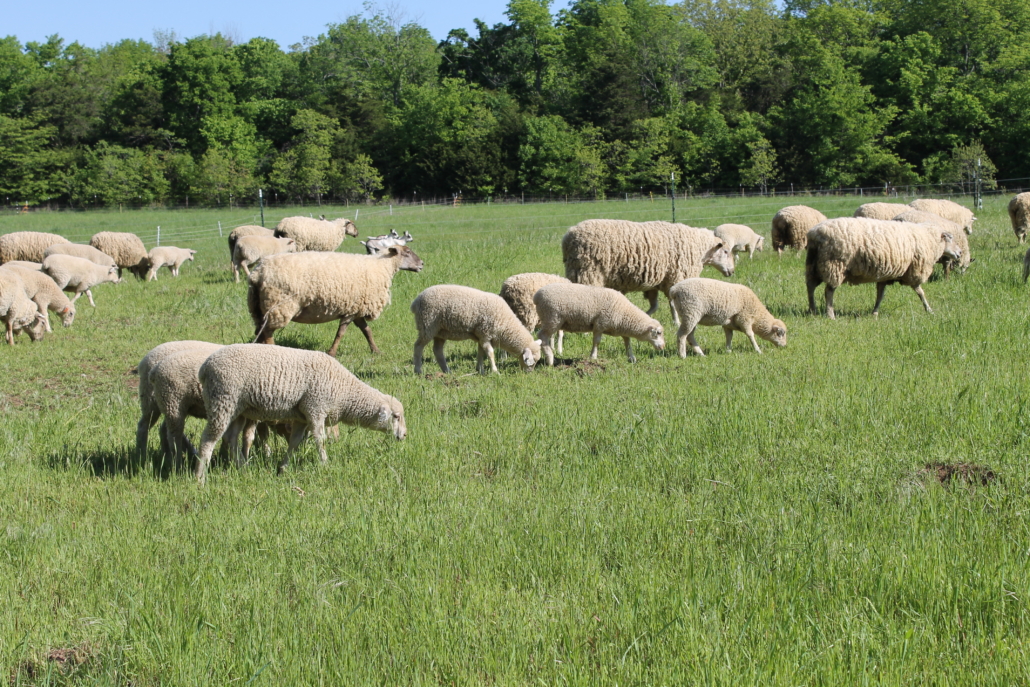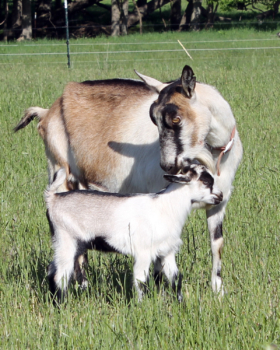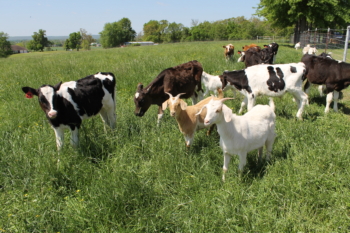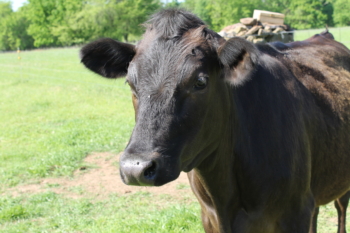Tipsheet: Organic Management of Internal and External Livestock Parasites

Photo: Robyn Metzger, NCAT
By Linda Coffey, NCAT Agriculture Specialist
Livestock parasites are present on our farms. They have many attributes that allow them to survive difficult environments and seasons, and it is literally impossible to completely eradicate them. When parasite numbers are too high for the host animals’ immune systems to control, we will observe signs of disease, including weight loss, appetite loss, depression, weakness, and, if not treated, death.
Yet animals have always coexisted with these parasites. The keys to coexisting include:
- A strong immune system
- Low exposure to parasites
A strong immune system is naturally present in some animals. Selecting those breeds and individuals is part of a good animal-health strategy. Immune systems are encouraged through good nutrition and low stress, including healthy living conditions and calm handling.
Meanwhile, exposure will not overwhelm the strong immune system if parasite numbers are kept low. This is accomplished through sanitation (clean water tanks and feed troughs) and through pasture management.
Several keys to preventing illness from parasites are stated in the U.S. Department of Agriculture (USDA) National Organic Program (NOP) Livestock Health Care Practice Standard (7 CFR §205.238).
- Producer must use preventive practices, including the following:
- Select species and types of livestock suitable for local conditions and resistant to prevailing diseases and parasites
- Provide adequate nutrition
- Establish housing, pasture conditions, and sanitation practices to minimize occurrence of diseases and parasites
- Keep stress low
- When the above measures are not enough to prevent sickness, a producer may use synthetic medications, provided they are allowed under §205.603 (the National List of Allowed and Prohibited Substances, but ONLY in certain circumstances. These include:
- Breeding stock, when not in the last third of gestation but not during lactation for progeny that are to be sold, labeled, or represented as organically produced
- Dairy stock, when used a minimum of 90 days prior to producing organic milk
- A producer is PROHIBITED from:
- Using synthetic parasiticides on a routine basis
- Using synthetic parasiticides on slaughter stock
There is very limited use of certain parasiticides allowed in organic production. However, organic producers are obligated to treat sick animals, even if it means the animal loses organic status (check §205.238(c)(7)). For example, if a group of young lambs becomes parasitized and organic treatments fail, the producer is required to treat them with effective treatments. Then one of two situations will apply:
- If animals are treated with synthetic dewormers on the National List, they are no longer eligible for organic meat or fiber production. Such treated animals are eligible for organic milk production after a withdrawal period.
- If animals are treated with synthetic dewormers NOT on the National List, those animals may no longer produce organic milk, meat, or fiber. However, they do not have to be removed from the herd as they may be used as breeder stock.
Producers must identify and note clearly in the records which treated individuals no longer have organic status.
Internal Parasites
Internal parasites can become a problem under certain circumstances:
- Where there is a concentration of susceptible animals
- When weather is humid and warm, or when pastures are irrigated
- For young stock before immunity has developed
- During times of stress, especially for females giving birth and lactating
- When animals are grazing and are left in one area for too long;
- When animals are returned to a grazing area too soon.

Lactating females and young stock are more susceptible to internal parasites. Photo: Robyn Metzger, NCAT
Grazing management is the single most important thing a producer can do to prevent illnesses from internal parasites. See ATTRA’s Tools for Managing Internal Parasites in Small Ruminants: Pasture Management for a full discussion on this topic. Principles apply to other livestock as well, though cattle are less susceptible than sheep or goats to internal parasitism.
- Do not allow livestock to graze shorter than three or four inches, because internal parasite larvae will be concentrated near the ground level, generally speaking.
- Use multispecies grazing to break parasite cycles; cattle do not share parasites with sheep or goats. Sheep and goats DO share parasites.
- Allow pastures to rest by grazing with a different species of livestock or cutting for hay before coming back to graze the same pasture again. A 60-day rest will also help internal parasite levels naturally die back.
- Provide diverse pastures. Having many forage species present will promote intake and also improve the nutritional quality available for the livestock. Some plant compounds may have medicinal properties that promote animal health.
- Provide browse. Internal parasite larvae will not be present on the leaves, and the plants may provide medicinal substances as well.
- High-tannin forages such as sericea lespedeza have been shown to reduce fecal egg counts in sheep and goats. See ATTRA’s Tools for Managing Internal Parasites in Small Ruminants: Sericea Lespedeza for more information.
- Graze younger, more parasite-susceptible stock first on fresh pasture that is less contaminated by parasite larvae to help protect the health of these more-vulnerable animals.
Providing excellent nutrition, including trace minerals, will help livestock by boosting their immunity, making them less susceptible to parasites and other diseases.
Good sanitation is also essential to encouraging good animal health and minimizing internal parasites and flies. Remove manure and keep water and feed troughs clean.
Selecting animals that have inherent resistance to internal parasites is required by the USDA organic regulations. Keep good records and cull those animals that are most susceptible. See ATTRA’s Tools for Managing Internal Parasites in Sheep and Goats: Animal Selection for an explanation of why and how to identify your strongest livestock.
Organically Acceptable Dewormers
If you farm or ranch in a region with high internal-parasite pressure, then you have a particularly difficult challenge. There are very few organically allowable products available to assist you.

Multispecies grazing can help break parasite cycles. Photo: Robyn Metzger, NCAT
Diatomaceous earth (DE) often is touted as a parasiticide and is commonly used by organic producers. Although it is heavily promoted as a dewormer, the efficacy of DE has not been proven. If you choose to use DE, make certain that it is part of a more comprehensive parasite management plan. Also be certain that you are using an organically allowable form of diatomaceous earth (not the kind used for pool filters), and remember to consult with your certifier before adding new health products into your Organic System Plan (OSP).
Several herbal agents also are reputed to be useful for deworming livestock. Their efficacy has not been shown. The Sustainable Agriculture Research and Education (SARE) program offers many opportunities to learn about research into innovative or alternative internal-parasite control. Learning about the research that already has been done can save a lot of effort, time, and money—and improve the wellbeing of your animals.
External Parasites
Common external parasites, also known as ectoparasites, are lice, mange, keds, and ticks. External parasites cause reduced rates of weight gain and loss of animal condition, and they decrease production rates due to animal discomfort (e.g., skin irritation) and blood loss.
Environmental and weather conditions contribute to ectoparasite infestations. In humid areas, for example, external parasites such as ticks are more common in animals that graze close to woodlands. Animals that are in confinement and very close to each other and animals in cold weather conditions are prone to suffer from ectoparasites. Preventive strategies could include the following:

Providing adequate space for exercise helps reduce animals’ stress and makes them less likely to suffer
from external parasites. Photos: Robyn Metzger, NCAT
- Segregating animals new to the farm for at least 21 days. They should be monitored closely and treated if necessary.
- Separating infested animals from the herd
- Ensuring good feed quality and, for ruminants, a constant supply of free-choice minerals. Low stress and good nutrition help animals’ immune systems thrive.
- Employing stress-reducing practices, including the following:
- Providing adequate space for animals to exercise and for
animals to eat without excessive competition - Providing quiet, calm care when moving or otherwise working with livestock
- Providing adequate space for animals to exercise and for
There are several organic treatment options for external parasite infestations. These treatments are generally allowed, but not always effective. If you plan to use them, they should be listed in your OSP and monitored for efficacy:
- Liquid enzymes
- Diatomaceous earth and garlic powder
- Soap
- Organic plant oils (e.g., soy and canola)
Sunshine is another “treatment” known to be effective against lice infestations. Also, for calves, housing them separately will cut incidence of lice versus group housing. See the eXtension article listed below for more practical tips.
Talk with your certifier before using any treatment materials that are not listed in your OSP.
Flies are another example of small but costly pests. Here are a few tools for managing fly
populations organically:
- Sanitation practices that keep facilities clean and dry will reduce breeding
grounds for flies - Physical traps, including sticky tapes and larger fly traps
- Natural predators such as bats and predatory wasps
- Composting manure, mortalities, and afterbirths

Photo: Robyn Metzger, NCAT
If you get good control of the situation early in the fly season, it will be easier to keep the
fly population down later in the year. Using all available tools will make this more manageable. Contact your Cooperative Extension Service for more on Integrated Pest Management (IPM) for flies and other pests. Another resource to consult is ATTRA’s Sustainable Pest and Weed Control Database. This is a searchable database designed to help farmers and ranchers find preventative techniques and possible treatments for many pests and diseases. Organic Materials Review Institute (OMRI)-listed products are noted in the database. Remember always to check with your certifier before using any material and include your plans in your OSP.
Questions
Are you using organically allowed strategies and techniques for preventing and controlling internal parasites in livestock? Success is more likely when several of these strategies are used together. Options include, but are not limited to, the following:
- Pasture rotation
- Controlled grazing
- Multispecies grazing
- Dragging pastures to disperse manure piles
- Fecal sampling as a monitoring tool
- Selective breeding for resistant stock
- Sanitation
- Herbal treatments (use caution—see SARE research)
- Diatomaceous earth (use caution—see SARE research)
- Allowed synthetic anthelmintics; currently Ivermectin, Moxidectin, and Fenbendazole (limited use only)
Prohibited materials and techniques include, but are not limited to, the following:
- Most synthetic deworming agents (required to be used if medically necessary, even though the animal
loses organic status) - Ionophores—antibiotics that control protozoan parasites, such as coccidia
Are you using organically allowed strategies and techniques to control or prevent flies, mosquitoes, and external parasites? Options include, but are not limited to, the following:
- Pasture rotation
- Multispecies grazing
- Dragging pastures to disperse manure piles
- Manure management
- Sanitation
- Ventilation and moisture control
- Screening
- Fly parasites and other beneficial insects
- Bat conservation
- Purple martins and other insectivorous birds
- Walk-through fly traps
- Sticky traps
- Flying-insect traps
- Electric bug zappers
- Biological pesticides
- Diatomaceous earth
- Botanical pesticides and preparations
Prohibited materials and techniques include, but are not limited to, the following:
- Most synthetic insecticides and acaricides
- Synthetic insecticidal ear tags
Further Resources
Fly Management in the Organic Dairy Pasture Webinar
This link includes the webinar, and a link to an excellent article authored by the presenters. The article, “Integrated Pest Management Guide for Organic Dairies,” is 38 pages long and covers life cycle, identification, and organically approved methods of controlling flies, lice, mites, and grubs. Both the webinar and the article are applicable to all organic livestock operations.
Organic Dairy Herd Health: External and Internal Pests and Parasites
This is a concise article with helpful tips.
USDA Organic Regulations 7 CFR 205
USDA National Organic Program Handbook
USDA National List of Allowed and Prohibited Substances
Organic Materials Review Institute (OMRI)
Tipsheet: Organic Management of Internal and External Livestock Parasites
By Linda Coffey, NCAT Agriculture Specialist
Published July 2015
IP503
Slot 516
This publication is produced by the National Center for Appropriate Technology through the ATTRA Sustainable Agriculture program, under a cooperative agreement with USDA Rural Development. This publication was also made possible in part with support from U.S. Department of Agriculture’s Agricultural Marketing Service, National Organic Program. ATTRA.NCAT.ORG.


